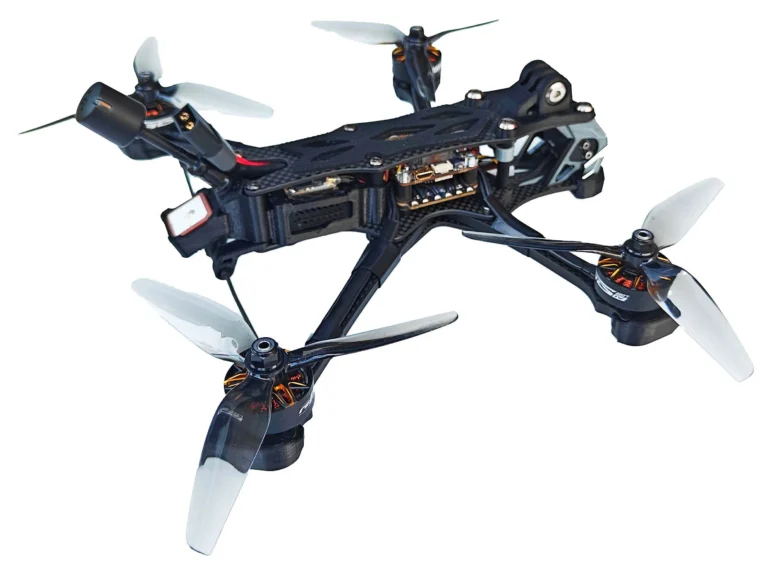
An FPV drone is an unmanned aerial vehicle (UAV) with a camera that wirelessly transmits video feed to goggles, a headset, a mobile device or another display. The user has a first-person view (FPV) of the environment where the drone flies and may capture video or still images.FPV drones are often used for racing or aerial photography and videography. They offer an immersive experience for the pilot, as they can fly the drone as if they were inside it. The pilot can control the drone’s movements and see the environment from a unique perspective.
Types of FPV Drones:
- Racing Drones: Built for speed and agility, these are lightweight and durable.
- Freestyle Drones: Designed for tricks and complex maneuvers.
- Cinematic Drones: Optimized for smooth, high-quality video capture.
What are FPV drones commonly used for?
Drone photography allows images and audio/video content to be captured that might not be otherwise possible. The capacity of these to enter environments that are unsafe for humans makes them effective for search and rescue missions.
Should I get FPV or normal drone?
FPV in the hands of a good pilot can get you deep into the action, normal drone footage tends to observe the action from a distance. NOTE: Always make sure your chosen pilot has the correct credentials and certifications.
Which is the drone used by professionals?
DJI Mavic 3 – Best commercial drones for photography/videography. An updated version of the DJI Mavic 2 Pro, the DJI Mavic 3 is the best video drone that takes everything we loved about the Mavic 2 Pro and makes it better. This drone with longest flight time of up to 46 minutes makes you rarely worry about battery life…
What drones do army use?
The Department currently operates more than 11,000 UAS in support of domestic training events and overseas contingency missions. These aircraft range in size from the small RQ-11B Raven to the largest RQ/MQ-4 Global Hawk/Triton, which weighs more than 32,000 pounds.
How high can a FPV drone fly?
In the United States, as well as many other countries, the law sets a strict limit of 400 feet above ground level. Despite this legal ceiling, drones can technically reach altitudes up to 10 kilometers (33,000 feet).
How fast can FPV fly?
Legal restrictions in various countries, including the United States, typically limit the top speed of consumer drones to around 100 mph. These/racing drones are designed for speed and agility and can reach speeds in excess of 100 mph, prioritizing high-speed performance over image photography capabilities.
What is the #1 drone in the world?
After test-flying 33 drones, we’ve concluded that the DJI Air 3 is the best because it combines a high-quality main camera, a useful telephoto camera, and the latest autonomous technology in a light-enough and relatively affordable package.
Can I fly FPV drone in rain?
As mentioned before, drones without an IP rating should not be flown in the rain as they are not considered water-resistant.
What are the limitations of the FPV drone?
You must have a visual observer colocated with you that can see the UAV if flying FPV. You must stay below 400 feet Above Ground Level (AGL) or the maximum height allowed by LAANC for the area. Follow all FAA airspace restrictions including TFRs and NOTAMs. Never fly near other aircraft.
Can you fly FPV with phone?
Drone pilots wear a head-mounted display in the way of special goggles (or even mobile phones adapted as goggles) that connect directly to a camera on board the drone they are flying.
How much cost of FPV Drone
The cost of an FPV (First-Person View) drone can vary widely depending on the features, quality, and brand. Here’s a rough breakdown:
- Entry-Level : For beginners, you might find ready-to-fly (RTF) drones with built-in FPV systems starting around $100 to $300. These usually come with everything you need to get started.
- Mid-Range : More advanced RTF drones or kits that offer better performance and more features typically range from $300 to $700. These might include higher-quality cameras, better build quality, and improved flight capabilities.
- High-End FPV Drones: Professional-grade FPV drones, including those for racing or cinematography, can cost between $700 and $1,500 or more. These drones often feature advanced flight controllers, high-definition cameras, and custom components.
- Custom Builds: If you’re building your own FPV drone, the cost can vary based on the components you choose. A high-quality custom build might range from $500 to $1,000 or more, depending on the components like the frame, motors, camera, and flight controller.
Conclusion of FPV Drone
In conclusion, FPV (First-Person View) drones represent a remarkable advancement in both technology and recreational activity, offering users a unique and immersive flying experience. By providing real-time video feeds from the drone’s perspective, FPV drones enable a more intuitive and exhilarating piloting experience, which is especially popular in racing, aerial photography, and exploration.
The evolution of FPV drone technology has led to significant improvements in camera quality, flight stability, and user control, making these drones more accessible and versatile than ever before. However, they also come with challenges such as regulatory compliance, the need for skillful operation, and potential safety concerns.
As FPV drone technology continues to advance, it holds promise for even more innovative applications, from advanced cinematography to new forms of recreational and competitive flying. Balancing these technological opportunities with responsible usage and adherence to regulations will be key to the continued growth and positive impact of FPV drones in various fields.